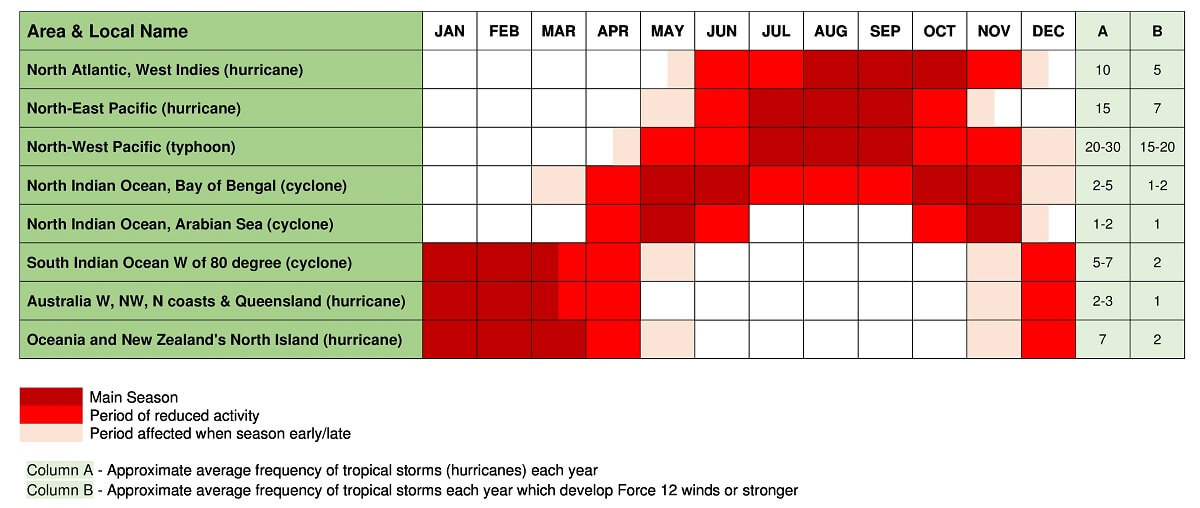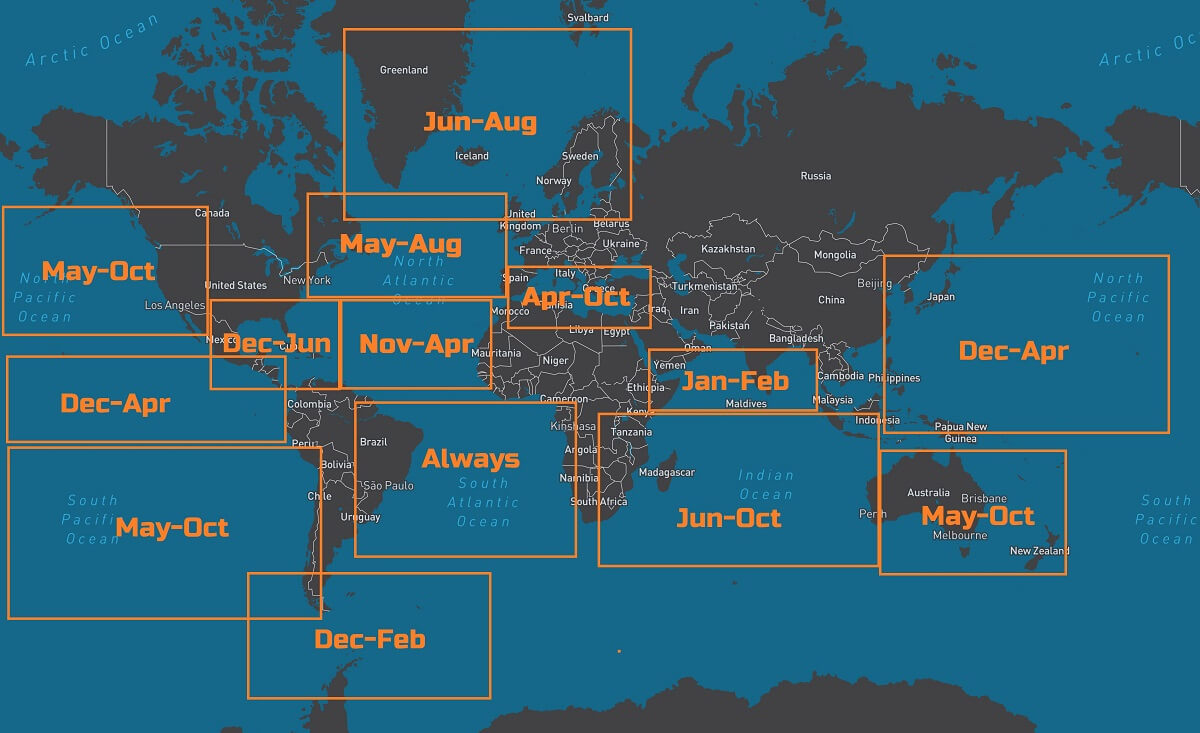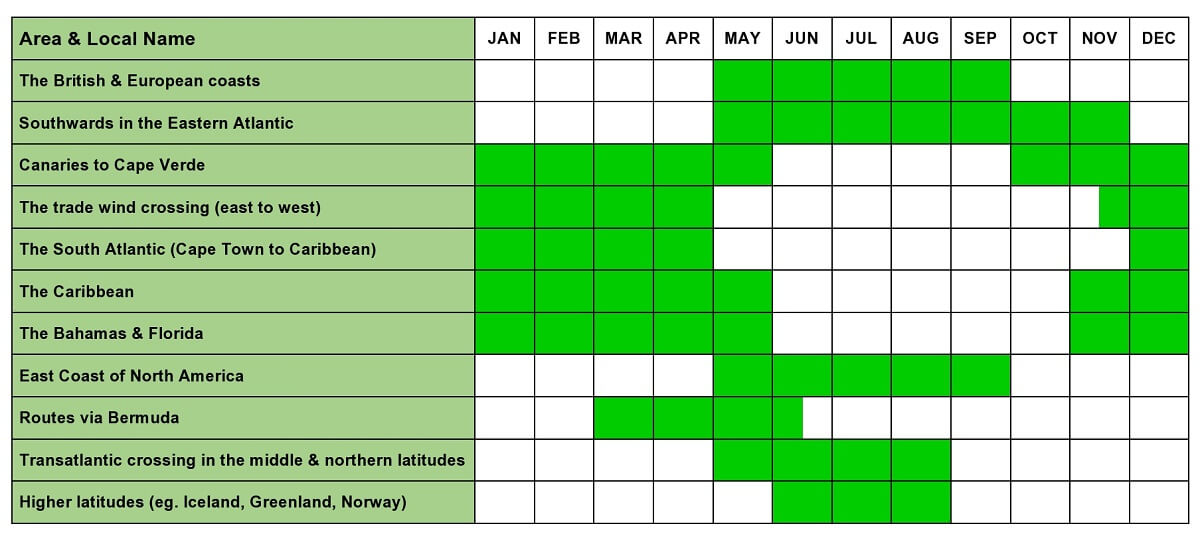By Marcin Wojtyczka
7 minutes readWhen’s the best time to go? (including a Map).
You should time your passages depending on the prevailing weather patterns (wind and current) through the seasons so that you can go with the weather, not against it, and can avoid dangerous sea conditions. In tropical areas, the optimum timing will be when the trade winds are properly established, but avoiding the hurricane season. In higher latitudes, frequencies of gales outside the season and the extent of ice fields should be taken into account.
It’s important to note that the specific details of timing a passage can vary depending on your departure and destination points, as well as your individual vessel and crew capabilities.
Key factors to consider when planning passages
- Weather patterns: Study the prevailing weather patterns for the specific route you plan to sail. It’s crucial to be aware of the typical weather patterns and the possibility of storms or adverse conditions along your intended route.
- Seasonal considerations: the world has distinct seasons that affect sailing conditions. The main consideration is to avoid hurricane seasons.
- Currents: Some currents around the world (e.g. The Gulf Stream) are very powerful. They can significantly impact the speed and direction of your passage. Understanding the current location and strength can help you plan your route and take advantage of its benefits.
- Safety and preparation: Regardless of timing, prioritize safety and ensure your boat is properly equipped and prepared. Ensure you have appropriate safety gear, navigation equipment, and emergency provisions on board. Familiarize yourself with safety procedures, including man-overboard drills, storm preparation, and communication protocols.
Hurricane seasons around the world
A Tropical Revolving Storm (TRS), or Tropical Storm, is an intense depression, which develops over tropical oceans. They are called differently in different parts of the world, but they are the same thing, i.e. deep low-pressure systems that forms in the tropical latitudes with sustained winds greater than or equal to Force 12:
- Hurricanes - North Atlantic
- Cyclones - West Pacific
- Typhoons - Eastern Asia
TRS cause very strong winds (64kt and more) and heavy seas and provide the most dangerous weather a seafarer can encounter. Even big ships are damaged or lost. Therefore, it should be the highest priority of every sailor to avoid them.

Sailing seasons around the world
Sailing seasons around the world can vary depending on the specific region and prevailing weather patterns. They can also vary from year to year. The map below can give you a rough idea of where you can go and when.

Sailing seasons in the North Atlantic

General guidelines
- Mediterranean: The Mediterranean sailing season typically runs from late spring (May) till early autumn (September or October). During this period, the weather is generally warm, with predictable winds and calm seas. Some areas, such as Greece and Croatia, may have longer seasons that extend into early November.
- The North Atlantic: The North Atlantic is a challenging and diverse sailing area, and the best time to sail depends on your specific route and destination. The northern part of the North Atlantic is best sailed during the summer and the southern part outside the summer months to avoid tropical storms.
- Northern Europe: Northern Europe includes regions like the British Isles, Norway, the North Sea and the Baltic Sea, and is best sailed during the summer months from June till August. The weather is generally milder, and daylight hours are longer. The coasts of Northern Europe are notorious for the severe gales that often come through early in September and last till April. Northern Europe has also a significant amount of marine traffic.
- Canary Islands and Madeira: The Canary Islands and Madeira, located off the coast of Africa, are popular sailing destinations. The best time to sail in this area is during the spring and autumn months (April to June and September to November), when the weather is typically pleasant, and winds are more consistent. The high season in the Canary Islands corresponds with the winter months in Northern Europe, attracting many sailors seeking warmer climates. The weather is fine during the winter months, but you can expect stronger winds and large swell. During the summer (low season) the trade winds can be less consistent, and there may be occasional calms or light winds.
- The Azores: The best time to sail in the Azores is during the summer months from June till September, when the weather is more settled and there is less chance of encountering large swell.
- Nova Scotia and Newfoundland: If you’re planning to sail in the waters around Nova Scotia and Newfoundland in Canada, the summer months from June till August are the most popular. This period offers milder temperatures, and reduced risk of storms and larger swell.
- Caribbean: The Caribbean sailing season is from November till April. This period is known as the dry season when the weather is warm, the winds are steady, and the risk of hurricanes is very low. The peak season, with the highest number of sailors, is from December till February.
- North America (East Coast and the Great Lakes): The sailing season on the East Coast of North America typically spans from late spring (May or June) till early autumn (September or October). The Great Lakes have a shorter season, usually from June till September, as they are frozen during the winter months.
- North Pacific: The sailing season in the North Pacific varies depending on the specific area. Along the west coast of North America, from California to British Columbia, the summer months (June to September) generally offer more favourable weather conditions for coastal cruising. However, this region can experience fog and variable winds.
- South Pacific: The South Pacific sailing season typically runs from May till October. During this period, commonly referred to as the “South Pacific cyclone season,” the weather is generally more stable, and the risk of tropical cyclones is lower. Popular destinations such as French Polynesia, Fiji, and the Cook Islands are best visited during this time.
- Central Pacific: The Central Pacific, including Hawaii and the islands around the equator, offers year-round sailing opportunities. However, it’s important to note that the region experiences trade winds, which can bring consistent but sometimes challenging wind conditions. In Hawaii, the summer months (May to September) tend to have lighter winds and are popular for sailing.
- East Asia: The sailing season in East Asia varies depending on the specific region. In general, it is divided into two seasons: the dry season and the wet season. The dry season, with more favourable weather conditions, typically runs from November till April, while the wet season, characterized by monsoons and increased rainfall, lasts from May till October.
- South America: The sailing season is typically from November till March. This period corresponds to the Southern Hemisphere summer when the weather is milder, and daylight hours are longer.
- Southern Ocean: The Southern Ocean is known for its challenging and extreme conditions. Sailing in the Southern Ocean requires extensive experience and careful planning. The best time to sail is during the summer months in the Southern Hemisphere, from December till February. During this period, the weather conditions in the Southern Ocean are relatively milder compared to other times of the year. However, it’s important to note that even during the summer months, the weather can still be harsh, with strong winds, large swell, and rapidly changing conditions.
Recommended further reading
- Pilot (Routing) Charts - depict average weather conditions around the world for each month of the year. One of the best tools to help you time your passages.
- World Cruising Routes - great planning guide to nearly 1000 sailing routes covering all the oceans of the world. A must have for ocean sailors.
- The Atlantic Crossing Guide - well established as the standard reference for anyone planning an Atlantic voyage.
- The Pacific Crossing Guide - well established as the standard reference for anyone planning a Pacific voyage.
Fair Winds and Following Seas!
- Related articles:
- Navigation